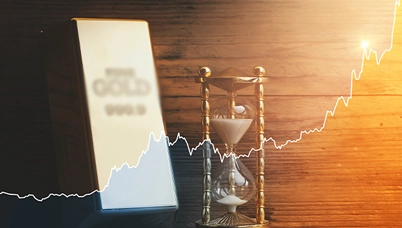An Overview of the Indian Stock Market
Posted On Wednesday, Jan 12, 2011
Have you noticed how the start of every New Year brings in astrological predictions for the coming year that clutter your inbox, hijack your TV shows and crowd your tabloids?
I don’t mean to sound cynical, but I just can’t understand how a mere change of date could bring about a drastic (and quite dramatic) alteration to your fundamental scenario? But still, beginnings always bring about a sense of clarity, that make you simply stand back and breathe in, thus making the start of the year, the apt time to take stock of what lies ahead.
And so here we are with our vision on just how golden the year ahead looks - Where will gold be heading? How well will it do? Will it continue to offer solace in the chaos created by global economies?
First, let’s replay
2010, What a splendid year it was for Gold! Exceptional performances by gold, with a 29.5% (in dollars) increase for the year marking the tenth consecutive price increase and a fourth double digit increase in the last five years. The table below shows the percentage growth in the price of gold over the years in various currencies.
Gold’s performance over the decade
Year | USD | INR | EUR | GBP | CHF | JPY | CNY | AUD | ZAR |
2001 | 2.5% | 5.9% | 8.1% | 5.2% | 5.3% | 17.6% | 2.4% | 11.8% | 62.1% |
2002 | 24.8% | 24.1% | 5.8% | 12.7% | 3.9% | 12.6% | 24.8% | 13.8% | -10.7% |
2003 | 19.4% | 13.5% | -0.2% | 7.8% | 7.3% | 8.0% | 19.4% | -11.2% | -6.9% |
2004 | 5.5% | 0.5% | -2.2% | -1.8% | -3.1% | 0.6% | 5.5% | 1.4% | -10.7% |
2005 | 17.9% | 22.2% | 35.1% | 31.4% | 36.0% | 35.7% | 15.0% | 25.8% | 32.0% |
2006 | 23.2% | 21.0% | 10.5% | 8.2% | 14.2% | 24.3% | 19.1% | 14.6% | 35.8% |
2007 | 31.0% | 16.6% | 18.5% | 29.3% | 22.0% | 23.0% | 22.5% | 17.8% | 28.6% |
2008 | 5.8% | 30.6% | 10.5% | 43.9% | -0.5% | -14.1% | -1.1% | 31.6% | 45.1% |
2009 | 24.4% | 18.9% | 21.1% | 12.2% | 20.4% | 27.6% | 24.4% | -2.4% | -2.5% |
2010 | 29.5% | 24.4% | 38.9% | 34.1% | 16.9% | 12.9% | 25.0% | 13.7% | 15.6% |
CAGR | 18.0% | 17.5% | 13.9% | 17.5% | 11.7% | 14.0% | 15.3% | 11.0% | 16.3% |
Data Source:Bloomberg
Compiled By:Quantum AMC
The price of gold continued to reach new highs on account of uncertainty in global markets. The dollar went through some rough patches in 2010, but its downsides were capped by the Euro’s own woes. The single currency was at times viewed as on the brink of a collapse as concerns about sovereign debt in peripheral Euro-zone countries plagued markets. Euro-zone concerns dominated the gold trade in the first half of the year. But this was countered by the idea of expanding the Fed`s bond-buying efforts, a second round of so-called Quantitative Easing (QE) aka money printing. Quantitative Easing policies of both the US Fed and the European Central Bank with some key big investors seeing this as a sign of inflation ahead and also likely currency value depreciation led to regard for gold as a better means of maintaining wealth.
What’s really driving gold prices?
A mix of Macroeconomic factors has underpinned this bull market in gold. Much of these factors are still in place, if not further intensified. A slow economy, low opportunity costs, negative real yields, wealth preservation, and central bank buying all have buoyed gold prices and are likely to support prices going forward too.
Negative real interest rates
In an effort to bail out speculators and the so called “too big to fail” highly levered financial institutions, the Fed embarked on an easy monetary policy lowering the cost of mutual funds by forcing the benchmark interest rates tonear zero levels. This has led to real interest rates falling way too low to offer realistic returns for bond investors.
Now, the Fed seems to have trapped itself. Lower cost of funds is necessary to repair these balance sheets and support their functioning. Any increase in borrowing costs will be a burden whose weight may threaten the so called ongoing recovery. While an action to raise rates would prove healthy over the long term, this is apparently unacceptable politically.
Chart: Real Interest rates and Gold

Source:Bloomberg
As long as the Fed controls nominal rates to levels under headline inflation, real rates will remain negative. More and more investors are shifting to gold during times of monetary inflation and to avoid losing real purchasing power year after year being in bonds. Even though gold doesn’t pay a yield, as long as it merely paces inflation, it is still a much better investment than bonds which lag behind inflation.
Erroneous Policy making
Rising deficits and the buildup of unsustainable amounts of debt are resulting in continuous devaluation of currencies. More Quantitative Easing measures are simply worsening the issue. The issue of nations accumulating unsustainable amounts of debt is eroding confidence in fiat currencies and is leading investors to move towards safer assets like gold. Unless policymaking is forced to follow the path of more fiscal sobriety, gold will keep gaining in value.
Looming long run inflation fears
This also creates inflationary prospects over the longer term and the potential for more asset bubbles. Increased liquidity on account of money pumping by central banks is not seen to be helping economic recovery but is feeding into asset prices. The price of many commodities has risen significantly. In an environment of increasing uncertainty, one would prefer holding on to a real asset like gold. Thus it’s not surprising to see investment demand increase significantly.
The Macro Aspect
There remains considerable nervousness about the state of both the US and Euro-zone economies. The former is struggling to pull out of recession with unemployment showing few signs of diminishing, while in Europe there are still major worries that countries like Portugal, Spain, Italy and even rudderless Belgium may find themselves in the same parlous financial state as Greece and Ireland, and that one or more of these countries may be forced into default (or restructuring as it is known nowadays). And a default, or defaults, could pose considerable problems for the global banking sector.
The Fundamentals
Demand for gold has been hitting on all cylinders. Investment demand has been highly robust. With people losing faith in the government’s ability to undertake rightful measures to support economy and currencies, they are tilting towards gold for a rescue. Also, despite continuous price increases, demand from traditional buyers has been very strong. Indian consumption numbers for 2010 are estimated to be around 700 tons, that’s a whopping 25% increase from dismal 2009. It indicates that buyers have adjusted to prices and that’s mainly on the back of higher prices expected in the future. Still, India’s demand for gold is likely maintain its current levels. On the other hand, Chinese demand for the metal has increased dramatically. We have always believed in the Chinese potential for gold consumption and it has taken many on the back foot unleashing its appetite for gold. With the liberalization of the gold market and government’s encouragement for gold consumption, Chinese demand will only increase from here on. Demand from central banks like Russia and China can be expected to continue given its low allocations to gold as they move away from dollar.
On the supply side, mining saw some positives. On the other hand central banks sales were almost absent. IMF completed sales of the mandated 403.3 tons during the year. Surprisingly, scrap sales have not increased given the price increases. On the total, even with increase in mine supply, demand has largely exceeded supply, thereby lending support to prices. We believe that demand would ideally continue to outpace supply atleast over the next few years as investors continue to increasingly allocate to gold.
Headwinds
Many opine that interest rate increases by the Fed and a growing economy would dent demand for gold as an alternative, and investors would start dumping gold and move to bonds as rates increase. However, negative real rates is one of the main drivers of gold currently. The current policy making is not poised to increase rates enough to make change them to positive. With the growth in the economy, inflationary aspects would be seen at large. Yes, it could still dent sentiment for the short term as and when it happens leading to a correction in gold prices. These would in fact be good opportunities to buy gold.
Outlook:
The relatively high prices seen over the past few years are well supported by fundamental factors. We believe that gold is rightly increasing in nominal value being the only currency whose supply is highly constrained. In simple words, gold is simply adjusting to changes in global monetary conditions. When a central bank increases their money supply, the price of other currencies adjusts upwards. This is true for all currencies including gold.
Long-term trends in gold prices are driven by changes in the overall level of confidence in the monetary system and the economy. Therefore, to analyse gold over the long term, it needs to be seen as a monetary asset rather than a commodity. Given the current economic backdrop, where governments are struggling with problems like rising deficits and unsustainable debts, it is indeed logical for gold prices to increase in value. With policy makers continuously debasing currencies, gold will be viewed as a safe haven investment, lending some solace to the chaos.
Gold prices are clearly trending upwards over the long term. The macro-economic and supply-demand drivers point to a continued increase in gold prices. Demand from consumption centers like India and China seems to be on a firm footing. Investment demand has been robust and would continue to grow lending support to gold prices. We do not believe that there is a ‘bubble’ developing in gold, as the relatively high prices seen recently are supported by fundamental factors. Broad themes that would drive gold prices are currency debasement, rising inflationary fears and diversification of investments and reserves to gold. Gold as a percentage of total investments is still very miniscule. Even a small shift to gold can lead to large price increases. If concerns surrounding Quantitative Easing, monetization and European sovereign debt defaults trigger another broadly based loss of risk appetite, investors would no doubt want to increase their gold holdings.
The uncertain macroeconomic environment and looming inflationary threat over a long term reiterates the need for gold in one’s portfolio. Make a strategic allocation to gold because it`s the counterweight to paper money which is continuing to lose credibility as a store of value.
Disclaimer:
The views expressed in this article are the personal views of the Fund Manager of Quantum Gold Fund. The views constitute only the opinions and do not constitute any guidelines or recommendation on any course of action to be followed by the reader. This information is meant for general reading purpose only and is not meant to serve as a professional guide/investment advice for the readers. This article has been prepared on the basis of publicly available information, internally developed data and other sources believed to be reliable. Readers are advised to seek independent professional advice and arrive at an informed investment decision before making any investments. Please visit – www.quantumamc.com/disclaimer to read scheme specific risk factors.
Related Posts
-

Understanding GIPS: The Global Standard for Performance Reporting
Posted On Wednesday, Jan 14, 2026
In the world of investing, everyone loves a good performance number.
Read More -

Equity Monthly for January 2026
Posted On Friday, Jan 02, 2026
Indian markets remained range-bound in 2025
Read More -

Gold Monthly for January 2026
Posted On Thursday, Jan 01, 2026
Gold Market Review and Outlook: 2025–2026
Read More



